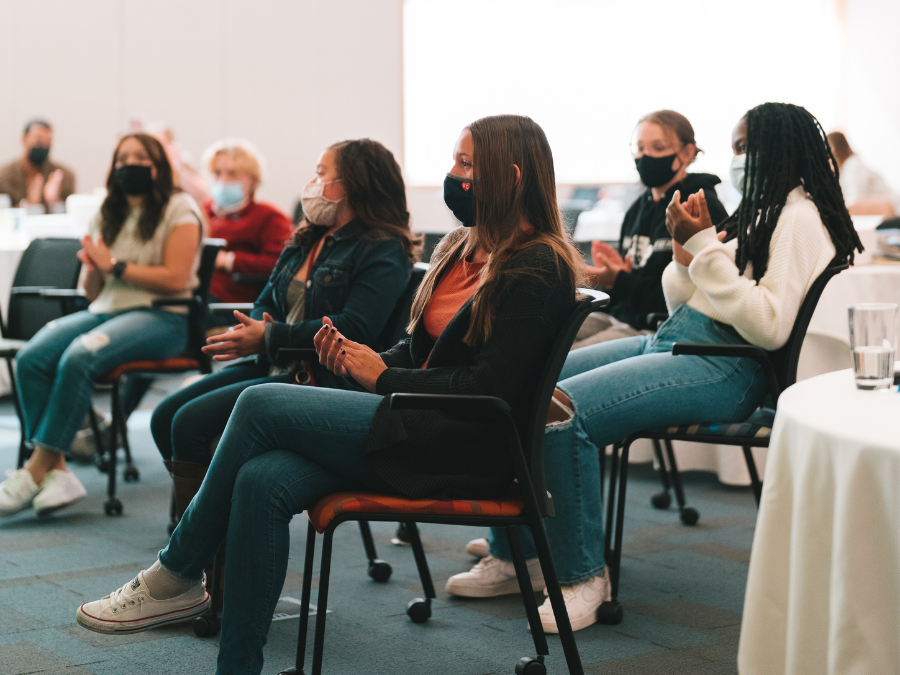It’s (Past) Time to Redesign the Teaching Profession
Key Points
-
Hiring more teachers is not enough to fix the current labor shortage.
-
We need to radically redesign the teaching profession itself to be a better opportunity for teachers AND students.
-
The only solution that will work in creating an equitable educational model is one that designs for empathy with the user.

By: Katie Kimbrell
If you’re not living under a rock—or not yet overcome by extreme compassion fatigue brought on by the onslaught of worsening crises in our society—you know that our education system is in dire straits.
According to a recent Forbes article, national research found that 54% of teachers surveyed in 2021 are considering leaving the teaching profession within the next two years. More urgently, Edweek reported that 48% of teachers have considered quitting in the last 30 days.
To be clear, these numbers are cataclysmic.
Our local numbers are probably not dissimilar from elsewhere in the country: According to a regional study by LeanLab Education, teacher burnout was among the top three challenges mentioned consistently by the near 250 educators surveyed. In a recent online survey by Kansas PAC, Freedom to Learn, 78% of teachers (of 780 responses) would not recommend their profession to students, while 80% of teachers would not recommend their profession to friends and family.
To be clear, again, these numbers are extremely bleak for both the retention of current teachers and the pipeline of future ones.
I don’t care if you don’t have kids, if your kids are grown, or if you think for some reason you’re shielded from this threat: This crisis should concern everyone. Just like when any core institution is threatened to subsist, reinvention is not just an opportunity to do better, but an imperative to survive—both for an institution, but more importantly, for our collective humanity.
This past weekend, I let myself go through a little mental exercise— a quick thought experiment if you will.
Backstory: My husband is a nurse and has been on the frontlines of this pandemic, caring for very sick Covid patients, wearing himself thin. Just like what we hear about in the news, he’s been through staff resignations, staff shortages, and unnecessary loss of life from the pressure on the healthcare system. We simply can’t pay or thank them enough, and unsurprisingly we don’t do either of those well.
Also, he’s a really good nurse. He just won the most prestigious nursing award the hospital gives (for which, by the way, he won a small wooden statue, a parking space, pastries for his floor, and a photo op with a hospital administrator—all of which is neither here nor there…actually it’s a bit here, and I’ll come back to it).
In his unit, he’s increasingly working alongside agency (contract) nurses to fill the mass shortages. Recently, he found out how much more they are getting paid to do the same job…and it’s way, way more. Within days, he was on the phone with an agency nurse recruiter. Her pitch was pretty easy and appealed directly to him as a human—she quickly showed him which hospitals locally where he could get 12-week contracts, how he could rest or travel in between, how much money he would make (way more than he currently makes), how he wouldn’t have to work holidays (and we have two-going-on-three-little kids, so this really matters to him). She spoke to the flexibility, his needs, his professionalism and expertise (did I mention he just won a huge award, for which he was recognized with basically a high five and a picture of himself in the hospital hallway?). In short, it’s not surprising that staff nurses are leaving in droves to work as agency nurses—there’s basically no good reason not to.
What would it take to design a profession so appealing that it attracts our best, brightest, and most inspiring humans?
Katie Kimbrell
As he was sharing this agency nursing opportunity with me later, I immediately, flippantly blurted something aloud to the effect of wow, if this option existed for teachers—(a profession that is also exhausted and hemorrhaging right now)—it would be wildly popular.
And then my wheels started turning on the idea: A model for educators to work in 12-week stints…to get paid (competitively) per module/course…to enable them to take off when they want/need it… to be much more flexible with their time and space…and so on. Agency teaching…for a moment, I let myself suspend judgment, questioned my assumptions, and dreamed briefly about the possibilities. The further I went down this rabbit hole of a crazy idea, the more viable it actually seemed.
My husband and I went back and forth on it for a while, and within an hour, I was on the phone with innovative educators I know asking, “could this work?”
Design thinking in action
Very loosely, my little mental exercise was design thinking in action, what my team at Startland Education—a nonprofit team of former educators passionate about the potential of young people and urgent need to disrupt obsolete teaching and learning models—preaches and teaches to young people, educators, and entrepreneurs in our community every day.

Design thinking is basically this: Ask big questions, empathize with the user, understand the pain points and the data, ideate possible solutions, empathize with the user, don’t avoid the radical ideas, make a basic version of one of your ideas, name your assumptions, test what works and what doesn’t, empathize with the user, and so on.
Above all, design with empathy for the user, or what you’re designing simply won’t work.
When it comes to the teaching profession, what we’ve designed simply isn’t working anymore (when and if it ever did is another debate)
Please note that this piece is not making an argument for the concept of agency teaching (ie. please don’t send me your theses on why my idea is bad), but rather to demonstrate a point about the need to rethink the teaching profession and to treat educators as humans and critical stakeholders in the way we redesign it.
Would my spitball idea of agency teaching address the primary needs and pain points we are hearing from teachers right now? Definitely. Would it then force total rethinking and restructuring of school itself? Most likely. (Would it be the most idyllic long-term solution for the system to function? Completely debatable, but it would put some necessary pressure on the system to reinvent itself, which not even a pandemic has been able to do).
I’m curious, what’s your immediate reaction to this call to action to completely redesign the teaching profession? What stakeholder are you in this whole thing? What lens are you applying? What assumptions are you making?
Perhaps you are a parent, and reading this makes you immediately anxious about the instability radical change in a (infamously) slow-changing institution would mean for your family personally, especially in these uncertain times—and on the heels of a couple of very tough years. As a parent myself (and a friend, sister, etc.), I get this.
Or perhaps you’re an education leader, who feels too overwhelmed by the barrage of daily problems and operations to rethink something like the teaching profession that is so seemingly fundamental to the whole system—it may even feel above your pay grade.
To you—and all other influential stakeholders in the education system, such as lawmakers, philanthropies, etc.—I will say this: if addressing the reality of a rapidly declining and unsatisfied teaching workforce is not at the top of the list of problems you are trying to solve, anything else you do will not work. Put quite simply, you are on the verge of not having a workforce.
Six points on the reinvention of teaching:
- This point above all other points: Humans matter first. This is a system of humans…first. While I believe the main users are the students, the teaching workforce is an inextricable main user group. By and large, happy/empowered teachers equal happy/empowered students. The morale of these groups mirror each other. And this ‘humans first’ point is larger than just schools. As we know, all industries have been hit by worker shortages. Somewhere I heard the Great Resignation called the Great Realignment, as workers are reevaluating their personal values, priorities, and needs. We need systems that work for humans, or they simply won’t work. And that’s a double entendre.
- Reinvention is not incremental, but radical. School improvement (incremental) is distinct from school redesign (radical). This op-ed in EdSurge highlights the problem well, but I think the posited solution (4-day weeks, which are already becoming increasingly commonplace) is a bit basic. I don’t think it responds to the enormity of the problem, and could even backfire in ways that attempt to justify extremely strenuous 12-16 hour days within those 4 days. In short, it just condenses what’s not working about the demand and rigidity of school into four days. The author is spot on about the workforce’s need for flexibility, but on solution, let’s think bigger. We have to go back to the drawing board, not duct tape it all together.
- Let’s not lose sight of quality when focused on quantity. We don’t just need more teachers; we need the teaching profession itself to be a better opportunity. Many efforts to address the teacher shortage crisis seem to be around pipeline-building and recruitment, not around improving the profession itself. While my own bias might be that that is cart before the horse, the reality is we need both to happen—concurrently and quickly. I see some great work on the former need (shoutout to our friends at LatinX Education Collaborative and BLOC). These organizations have amazing visions for increasing representation in schools, and core values like humanity and liberation (what school should represent), AND, as I see it, the profession has to dramatically evolve to actually fulfill this vision of a fresh, diverse, empowered teaching workforce—otherwise, the profession we are recruiting people into is systemically problematic and will continue to churn and burn great talent.
- Let’s talk about assumptions. When we redesign anything, we must name our assumptions and test which assumptions are true. When it comes to education, there are so many deeply held assumptions about what has to stay the same and what doesn’t; what’s possible and what’s not. Some perceived fixed variables are not real; they’re just that: perceived. A classic example of this in schools is the bell schedule. Many secondary schools operate under a fixed assumption around how many hours a day students need to be in which classes. I call it, the assumption that the school day has to mirror the diploma: if you get an hour of math credit, you’re in an hour of math a day, and so on. This assumption (or one similar) is so incredibly false yet so incredibly normalized. As we rethink the teaching profession, it’s imperative that we collectively challenge our assumptions about what the purpose of school is and what school has to be…or doesn’t; which variables are fixed, and which aren’t. Innovation in general tends to unveil false assumptions and fundamentally change the way we think and operate.
- When teachers leave in record numbers, which is already happening, they will take personal heat for the system’s sins and largely won’t be applauded for making a hard decision to do what’s better for themselves, their careers, and their families. But what about kids? How dare teachers just selfishly leave them stranded? If not them/us, then who? When I left teaching several years ago, I had internalized some of these thought processes and felt guilty for leaving kids and families (after all, the system’s problems weren’t their fault—see point #6). It’s this exact rhetoric, though, that misplaces the weight of the world on teachers’ shoulders. It is a rhetoric that preys on their altruistic nature. It manipulates their good intentions for entering the profession in the first place. It creates a bit of a Stockholm Syndrome relationship between unhappy, unwell teachers and the schools they teach in. Frankly, I think this rhetoric is abusive. Good teachers shouldn’t have to be society’s martyrs.
- When discussing any of the problems and crises in the education system, I often hear veiled allusions to ‘kids these days’. Kids are not the problem They are in no way the problem. I reject its premise so deeply, I’m not even going to expound on this (I actually believe kids are the great hope for fixing all of our world’s biggest problems, but that’s a different conversation). Teachers aren’t the problem, and they can’t carry the responsibility of redesigning their profession, other than departing in masses, which, again, we are on the cusp of. Instead, here are some other parties we can hold accountable and call to participate in the Great Redesign of the Teaching Profession: State and federal legislators; universities; teacher preparation programs; superintendents and various levels of district leadership; and local and/or national philanthropic organizations.

What do teachers want and need?
In design thinking, you always begin with big questions and with empathy for the users at the center of that question.
So let’s empathize. Here is what teachers definitely DON’T want: they don’t want amassing responsibilities they don’t get compensated for; they don’t want pats on the back; they don’t want to be told their kids are lucky to have them as we watch them wither away as human beings; they don’t want snacks in the teacher’s lounge or other underwhelming tokens of appreciation; they don’t want state legislators and a parent minority telling them how and what to teach; they don’t want to feel unsafe while doing their jobs; and they definitely don’t want guilt trips anything close to…if not you, then who?
So, what do teachers want and need then? What would it take to reengage and retain them in the system? Or better, what would it take for them to thrive, not survive? And even better yet, what would it take to design a profession so appealing that it attracts our best, brightest, and most inspiring humans? These are the most important questions to ask as we look to redesign the profession.
I can certainly share my own experience and feelings about these questions, but I can’t answer them alone. Asking a critical mass of past, present, and future educators these questions is where the empathy work begins—and therein the only way we will be on the right track in designing a system that works for all the humans inside of it.
Redesigning the teaching profession may be above all of our pay grades, frankly, but having clear eyes about the present and coming future of education means that we have the moral imperative to do it.
Katie Kimbrell is the Director of Startland Education, a program of Startland, a 501(c)3 nonprofit. At Startland Education, our mission is to bring human-centered design thinking to classrooms in order to create communities that value our youth and inspire them as future change leaders and entrepreneurs. To learn how Startland Education can equip and empower educators in design thinking at your school, visit startlandedu.org.




0 Comments
Leave a Comment
Your email address will not be published. All fields are required.